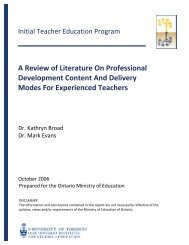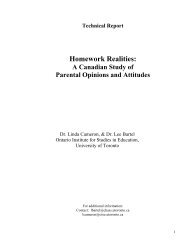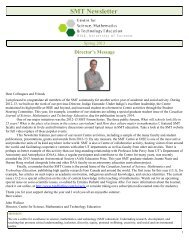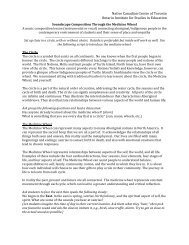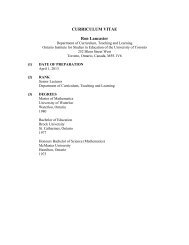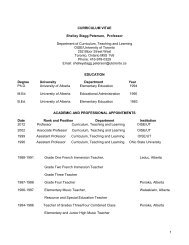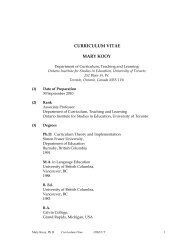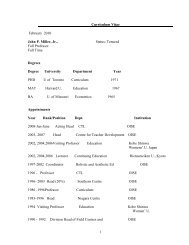The Ontario Curriculum, Grades 9-12 - Ministère de l'éducation ...
The Ontario Curriculum, Grades 9-12 - Ministère de l'éducation ...
The Ontario Curriculum, Grades 9-12 - Ministère de l'éducation ...
Create successful ePaper yourself
Turn your PDF publications into a flip-book with our unique Google optimized e-Paper software.
Green Industries, Gra<strong>de</strong> <strong>12</strong>, University/College Preparation<br />
(THJ4M)<br />
A. Green Industry Fundamentals<br />
A1. Species Classification and Geographical Regions<br />
A1. <strong>de</strong>monstrate an un<strong>de</strong>rstanding of species classification and i<strong>de</strong>ntification and explain<br />
relationships between species and geographical regions<br />
A1.1 distinguish between different plant and/or animal groups on the basis of key i<strong>de</strong>ntification<br />
characteristics (e.g., native and non-native species, dairy and beef cattle, <strong>de</strong>ciduous and<br />
coniferous shrubs, monocotyledonous and dicotyledonous plants), and i<strong>de</strong>ntify species<br />
using both common and scientific names (e.g., white birch [also known as paper birch or<br />
canoe birch] [Betula papyrifera] and Mountain paper birch [Betula cordifolia],<br />
euonymus [gen. Euonymus] and Emerald Gaiety [Euonymus fortunei ‘Emerald Gaiety’])<br />
A1.2 i<strong>de</strong>ntify geographical regions in Canada on the basis of classification criteria relevant to<br />
the green industries (e.g., plant hardiness, growing <strong>de</strong>gree days, elevation, soil type, soil<br />
moisture), and explain how geographical factors <strong>de</strong>termine the distribution of species in<br />
these regions<br />
A1.3 compare different kinds of ecosystems in terms of their biodiversity (e.g., a climax forest<br />
versus a rejuvenated forest, natural versus managed land, a cultivated field versus a<br />
greenhouse), and explain how biodiversity affects the stability of ecosystems (e.g.,<br />
monocultures versus diversified ecosystems)<br />
A2. Factors Affecting Growth and Product Quality<br />
A2. analyse the effects of biotic and abiotic factors on growth and post-harvest quality<br />
A2.1 analyse the effects of abiotic factors on growth and post-harvest quality (e.g., effects of<br />
differences in soil composition, climate, water quality and quantity, topography)<br />
A2.2 analyse the effects of biotic factors on growth and post-harvest quality (e.g.,<br />
physiological effects of pests and diseases, invasive species, genetic variations)<br />
A2.3 assess the effects of interactions between abiotic, biotic, and cultural factors on a variety<br />
of ecosystems (e.g., forests in various stages of natural succession, golf courses, fish<br />
farms, organic farms, riparian zones)<br />
A2.4 compare the effectiveness of different integrated pest management techniques for a<br />
variety of applications (e.g., cultural [tilling and mulching], physical [crop rotation],<br />
environmental [introduction of beneficial insects], biological [fungi, nutrients], chemical<br />
[pheromones, chemical pestici<strong>de</strong>s])<br />
A3. Designs and Processes<br />
A3.1 explain the steps required to create <strong>de</strong>signs or plans for a variety of applications in the<br />
green industries (e.g., timber cruising, surveying, perennial gar<strong>de</strong>ns, farms,<br />
environmental assessments)<br />
A3.2 explain advanced systems, processes, and techniques relating to the propagation,<br />
maintenance, and care of plants or animals (e.g., irrigation systems, tree support and<br />
protection systems, plantation tending, prescribed burning, regeneration)<br />
190 Environmental Education, <strong>Gra<strong>de</strong>s</strong> 9−<strong>12</strong>: Scope and Sequence of Expectations, 2011



